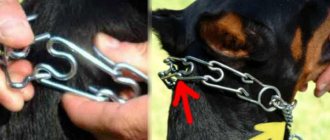It seems like just yesterday you brought your puppy home. But after a year he has grown a lot and can be considered an adult dog. True, it all depends on the size of the puppy’s breed. Large breed dogs usually reach full physical and emotional development later, at two years of age. Although other dogs may consider them mature much sooner, becoming less tolerant of their puppyish behavior. Although your puppy still loves to play and get up to mischief, his needs change with age. Therefore, you need to adjust his diet to help him stay healthy and happy.
Growing up is a process
It goes without saying, but your puppy is unique! Although puppy development follows a general schedule, don't worry if your puppy doesn't mature at the same rate as his littermates.
Typically, puppies become adult dogs between one and two years .
But that doesn't mean they wake up on the morning of their first birthday and suddenly become adult dogs! In fact, puppy maturation is a process and it varies from dog to dog depending on size, breed, socialization and more.
How to tell when a pet is dying
Unfortunately, the death of pets can occur suddenly. And the reason for this can be not only old age, but severe poisoning, injury or illness. Based on the changed habits and behavior, one can determine that this sad event will happen very soon:
- Rapid, intermittent breathing.
- Change in heart rate. The pulse of a dying animal becomes weak, thread-like, and in the last hours of life cannot be felt at all.
- Uncontrolled urination, defecation, vomiting. The animal is no longer able to control the body, the muscles are relaxed, and involuntary bowel movement occurs.
- Muscle weakness, lack of coordination of movements. The brain of a dying animal gradually dies and loses its neural connection with its muscles. Therefore, when the pet wants to get up, he fails to do so. He immediately falls on his side, crouches, falls and can no longer get up.
- You can often notice muscle spasms and cramps.
- Very old dogs experience muscle atrophy. The muscles are no longer firm and elastic, but feel like jelly to the touch. The animal cannot stand up at all, but only lies down.
- A few days before death, the dog may experience clouding or complete loss of consciousness.
- The skin loses its elasticity, becomes rough and hard. If you pull it back, it will no longer return to its place.
- A few days before death, the dog stops feeling tactile pain. At the same time, if a dog is sick with cancer, it is necessary to give it painkillers until the last minute, since the internal pain remains.
Sexual and physical maturity of dogs
Most dogs reach sexual maturity at around six months. Puberty is the physical stage at which a dog can physically give birth to puppies. Having puppies can seem very grown-up, but if you've ever spent time with a six-month-old puppy, you know they're not fully grown yet.
Likewise, a puppy may become physically mature before it is fully grown. Physical maturity is when your puppy reaches adult height, which varies by breed. In general, small breeds are fully grown at around 12 months of age, while larger breeds may take one to two years to finish growing.
© shutterstock
In fact, if you've raised a puppy, you've probably experienced the frustration of having a physically mature pet that doesn't quite know how to control its body.
Deviations from the norm and their correction
Knowing how many months dogs grow, you can easily determine deviations from the norm. The most common problems include the following:
- The bitch has problems with lactation or the litter is too large. In these cases, some puppies will be much smaller and weaker than their counterparts. In the wild, such animals die, but thanks to artificial feeding this problem can be avoided.
- Rickets. Develops with hypovitaminosis. The method of treatment depends on the cause of vitamin deficiency, which can only be determined after diagnosis in a veterinary clinic.
- Worms and infections. If babies are not growing well, be sure to get tested for helminths and make sure there are no viruses and bacteria. Remember that until all mandatory vaccinations are completed, your pets’ immunity is very weak and vulnerable.
Record your pet's parameters once a week to prevent lag in height and weight. For this you will need electronic scales and a tape measure.
If you suspect an illness, do not self-medicate. Not all drugs are suitable for a child’s body and can pose a serious threat to life if the wrong dosage is used.
Emotional maturity of dogs
On the other hand, emotional maturity is when a dog acts like a dog and not like a puppy. As with any aspect of a puppy's development, the process of becoming emotionally mature occurs over time. You may not see it, but one day you will realize that your puppy has become a dog.
Emotional maturity coincides with your puppy's hormonal surges leveling out. As puppies grow and become sexually mature, they may act out, test boundaries, and "get into trouble." But somewhere between one and a half years, your puppy will calm down and his adult personality will emerge.
Puppies mature at their own discretion, so it is difficult to determine the exact moment when a puppy becomes an adult. As your puppy grows, watch for signs of emotional maturity:
- Listens and responds appropriately to training
- Calms down easier
- “Listens” and responds to social cues from other dogs.
Sometimes the answer to the question “when is a puppy no longer a puppy” is simple: “when it can be said to be an adult.” This depends on your specific puppy and can happen over time.
Do external factors affect growth?
Breed is far from the only thing that affects the growth of an animal. In addition to this, the following factors should be taken into account:
- Floor.
Females will always be smaller than males.
- Balanced nutrition.
The better the diet, the stronger your baby will be. The main thing here is not to overdo it and not become obese.
- Health.
Lagging behind peers is possible in the presence of genetic diseases, as well as various infections. During illness, the body spends its energy on maintaining basic functions, postponing the process of growing up until later.
- Activity.
Physical activity allows you to keep your body in good shape. As with feeding, it is important to observe moderation. Otherwise, option 2: extra pounds from inactivity or injury from too much stress.
- Environment.
Constant stress is the same disease. It has a detrimental effect on development and can lead to stunting. It is most difficult for small dogs, as well as some hunting breeds with a delicate psyche.
Try to avoid negative factors and be sure to monitor your pet’s parameters at each of the stages listed above.
When to Switch from Puppy Food to Dog Food
Diet is one way to differentiate a puppy from an adult dog. Puppy food contains more calories than adult dog food because growing puppies require more energy to fuel the day. Once your puppy stops growing, you will gradually transition to adult dog food.
In general, you should start switching to adult formula dog food when your puppy stops growing. The exact “when” depends on the size of your dog:
- Small breeds: 9-12 months.
- Medium breeds: about 12 months.
- Large breeds: 12-16 months.
But remember: just because your puppy has stopped growing physically does not mean he is fully mature emotionally and mentally.
© shutterstock
The importance of monitoring a dog's development
It is known that dogs grow very actively until they are 6 months old. Subsequent development is no longer so rapid. The rate of weight gain depends not only on their breed qualities, but also on the conditions of detention.
The owner, who cares whether his dog grows up healthy, must constantly monitor how he grows, since this process has its own laws.
There are several factors that ensure the correct and active development of an animal at all stages of its life:
- rational feeding;
- proper physical development;
- developed immune system;
- good hereditary qualities.
During the growth period, first of all, it is necessary to monitor the following parameters:
- timely weight gain;
- increase in size according to the characteristics of the breed;
- changes in appearance according to the exterior;
- acquisition of certain physiological characteristics.
How to find out the age of a dog?
If your dog came from a shelter, you may not know exactly when she was born. Wondering how to tell if your new puppy is really a puppy?
Young dogs tend to be more active and energetic. As dogs age, they slow down. But even an older adult dog can have puppy bursts of energy! The best way to tell your dog's age is to observe the physical signs of aging.
Start with their teeth. If your new puppy has shiny white teeth that appear a little small for his jaw, he may be less than 16 weeks old. By the time dogs reach adulthood, they already have permanent teeth.
Other physical signs of aging include:
- Graying around the muzzle
- Cloudy or pale eye color
- Decreased energy or lameness
For dogs that are on the border between puppyhood and adulthood, it can be difficult to guess their exact age. You can always ask your veterinarian to estimate your dog's age.
Age-related problems and diseases
As dogs age, chronic diseases can worsen. It is often difficult for owners to recognize such diseases, mistaking their signs for senile symptoms. If you make the correct diagnosis in time and start treatment, you can extend your pet’s life by several years.
Older animals are most susceptible to the following diseases.
Joint diseases, muscle weakness (especially in large breeds)
Heart disease, heart failure. As a rule, this disease begins to appear in dogs over 5 years of age. Symptoms of the disease: heavy breathing, shortness of breath, weakness during physical activity, sometimes swelling of the paws, blue discoloration of the mucous membrane of the mouth. No matter how you are in a hurry, do not pull the dog by the leash, do not rush the elderly dog. Let him rest, take a breath. Be respectful of his age-related problems.
Kidney diseases
The kidneys filter and remove toxic substances and maintain water-salt balance. Experts believe that after 8 years, every dog suffers from kidney failure. But, unfortunately, serious symptoms of this disease may not appear until 60-80% of the kidneys stop functioning. Diagnosis is made only by blood and urine tests. The first symptom that should alert the owner is that the dog drinks more and asks to go to the toilet more often.
Diseases of the liver and gastrointestinal tract
With age, digestive problems, disruption of the liver and gastrointestinal tract may appear. The first symptoms of liver disease are loss of appetite and lethargy. In cases of more advanced liver disease, jaundice, vomiting, increased thirst and frequent urination, diarrhea or constipation appear.
For liver and gastrointestinal diseases, the most reliable remedy is an individual diet. Most likely, you will have to “place” a pet on it for the rest of its life. No matter how piteously the little tail looks at you, no matter how it begs and loves a piece of fatty meat or a bone, you will have to take all your will into your fist and not give in to this pleading look. The stricter you are in this matter, the more years of healthy life you will give your four-legged friend.
Problems with urination
Problems with urination are extremely painful for both the dog and its owner. Such problems can be a consequence of inflammatory processes in the bladder and kidneys. The animal cannot tolerate it and urinates involuntarily, often even in its sleep. Under no circumstances should you scold an elderly pet for this. The dog is well aware that he is doing wrong, but he cannot do anything.
Don't make your pet feel guilty. All his life he served you faithfully, all his life he did everything you wanted, all his life he endured your whims and bad mood. So tolerate this senile weakness of his, take pity on him, show him that in spite of everything, you still love him very much. And he doesn’t need more...
The opposite picture is observed when the animal has kidney stones. The dog cannot go to the toilet. Urination is rare and extremely painful, sometimes with blood. In this case, you should not torture the dog. It is imperative to show the animal to a specialist.
Allergy
As dogs age, their metabolism slows down. The dog becomes more vulnerable to harmful factors and harmful substances. Some animals may experience allergic reactions and itching. The dog begins to itch and hair falls out. Scratching causes wounds and bald spots on the skin. All this is very painful for a four-legged animal. It is useless to treat the consequences (wounds and scratches). First of all, you need to find out the cause of the allergy, and only then begin treatment.
Dental problems
Very often, old dogs' teeth begin to deteriorate. Grinding of teeth, caries, tartar - these are the main problems that can affect the animal’s jaw apparatus. Bad teeth have a bad effect on your pet’s well-being and health. The dog refuses to eat because every meal causes unbearable pain. Refusal to eat can lead to serious inflammatory processes and diseases of the gastrointestinal tract.
You need to regularly inspect your dog's mouth. Diseased and carious teeth are products of decay of the body. It is best to remove such teeth. Watch out for the formation of plaque and tartar. Carry out hygiene procedures regularly. Tartar formation can also lead to inflammation and tooth loss.
Hearing loss
Pets often lose their hearing as they age. On a walk it is very difficult to shout to them, but at home they do not hear when they are called to eat.
Decay of sexual function
Over the years, many animals' interest in the opposite sex fades, and in males this begins to manifest itself earlier. Bitches continue to be in heat until they are very old. Sometimes periods of hunting become longer than in youth. If in youth the hunting period was 3-4 days, then in old age it can last one or two weeks. The dog is ready to mate tirelessly, although such matings are already fruitless. Such an anomaly may indicate disease or inflammation of the uterus. In such cases, if the doctor recommends removal surgery, it may be worth agreeing, since growing tumors can threaten the dog’s health.
Oncological diseases
Unfortunately, as dogs age, they can develop cancer. It is often very difficult to recognize the disease in the early stages. The animal comes to the veterinary clinic when metastases appear. In this case, it is almost impossible to save the pet; the doctor can only make it feel better by prescribing supportive therapy. To reduce the risk of complications as a result of cancer, it is necessary to carefully examine and feel your elderly pet a couple of times a month. Any new growths or lumps are a reason for a visit to the veterinary clinic.
Conclusion
Still don't know if your puppy is an adult? Here's a checklist:
- sexually mature
- Physically mature
- Emotionally mature
- Responsive to learning
- Other dogs look at them and react to them as if they were other adult dogs.
Some puppies become dogs at one year of age, and some dogs take up to two years to fully mature. If you don't know how old your dog is, ask your veterinarian.
One way to ensure that your puppy grows into a well-adjusted adult dog is to keep him socialized throughout his puppy years!
Author of the article: Elizabeth Geyer. Elizabeth Geyer is a writer, teacher, and animal advocate with extensive experience with animals and a passion for bully breeds and big orange tabby cats.
Visit to a veterinarian
This is probably not the first time you have visited a veterinarian. The puppy was vaccinated, he underwent anthelmintic procedures, treatment against lice and ticks. Once your pet is older, you'll likely see your veterinarian much less often (once a year is recommended), but by 14 months of age, he'll need booster vaccinations to protect against diseases like rabies, parvoviruses, distemper, and influenza. . This examination is the right time to take measures to protect the dog from parasites: anthelmintic procedures and lice treatment are carried out.
It is also worth talking to your veterinarian during this consultation about the changes that are happening to your pet. Ask questions about exercise, toys, treats, and anything else that needs to be changed now that your puppy is older.
Puppy Development Stages
It is customary to distinguish several main stages in the development of dogs.
Sucker
It starts from birth until the mother stops feeding her puppies milk. Until about day 14, babies develop their senses - they learn to walk on all fours, explore their environment, try to play with their littermates, and gain other experiences of “communication” with reality.
After the first two weeks of adaptation to extrauterine life, the socialization of puppies begins. The more they become like dogs, the more clearly their natural instincts manifest themselves. During the games, the teeth begin to be actively involved and an understanding of the strength of the bite is formed, and, consequently, the restrictions “is possible” and “is not possible.” Leadership qualities are demonstrated in the struggle for the most delicious milk nipple, located in the groin area of the lactating bitch.
Puppies
From one and a half months to six months. During this period, there is active growth of tubular bones, teeth, muscles and sternum. With proper care and proper nutrition, the animal grows at the withers and approximately doubles its body weight.
The character also changes. The emotional connection with the mother is finally broken, more independence and self-confidence appear. It is important to start training your dog on time, otherwise it may feel permissive and try to establish its own rules of the game in the house.
Young animals
From 6 to 12 months. Against the background of a noticeable decrease in growth rates and weight gain, hormonal changes in the body begin. In males, testosterone levels increase, and in females their first heat appears. The attitude towards other dogs changes, the so-called flight instinct arises.
On the one hand, the call of nature and the natural search for a partner for mating, on the other hand, the obligation to obey the owner and be obedient. This period is similar to adolescence in humans - approximately 13-15 years. Therefore, the behavior becomes not always adequate: the dog may be nervous, not respond to commands, show anxiety and give other reactions that were not previously characteristic of it.
Ripening
From one to three years. The final formation of the exterior and character. The dog ceases to be a puppy and establishes a clear position of behavior in the pack (among other dogs) and at home. It is almost impossible to challenge leadership or, conversely, try to “restructure” the animal’s temperament.
To euthanize or not to euthanize a dog
Sometimes, when a pet is suffering from an incurable disease and even the best treatment does not produce any results and the animal is in unbearable pain, the veterinarian may suggest euthanasia. As a rule, such a solution is offered for incurable cancer, paralysis, and injuries incompatible with life.
To euthanize or not to euthanize a beloved pet is up to the owner to decide. But, in some cases, this is the only and most humane method. It’s better to quickly and painlessly help your beloved ponytail than to watch his unbearable, painful torment.
Yes, it is very difficult to decide to take such a step. It's hard to imagine that the sound of your favorite claws won't wake you up early in the morning. No one will wake you up by licking your face with a wet tongue. No one will run to the door, bursting into ringing barks, when they hear footsteps outside the door. No one will greet you joyfully from work and pester you to play with him.
If you realize that there is no other way out, be with your beloved friend until the very end. Do not abandon him in the last seconds of his life, do not leave him in the hands of strangers. Place your hand against the body of your furry loved one. Whisper in his ear how good he is. Even if he can no longer see that you are nearby, he will definitely feel it. It is important to him that you are nearby.
Why does a dog run away from home before dying?
There is an opinion that dogs and cats sense their approaching death and leave the house before they die. Why does this sometimes happen, because the dog is so attached to its owner that it literally follows on his heels all its life. There are several options to explain this phenomenon:
- Some believe that the animal senses the emotional state and anxiety of the owner, and in order not to disturb him, they try to leave. This is an erroneous judgment. Yes, many dogs sense the emotional state of a person very subtly. But for an animal, life and death are two identical natural states. You need to have human consciousness to leave home.
- Most biologists are of the opinion that a dog leaving home before its approaching death is explained by natural instincts, such as the departure of an old wolf from the pack.
Wolves are very loyal to their pack. Exhausted, the old wolf feels weak, he feels that he can no longer keep up with other relatives and, in order not to be a burden and to protect the young from attacks by larger predators, he leaves the pack. In addition, the old organism is a product of decay. It smells bad, and this smell can also attract other predators. Having strayed from the pack, the old wolf will most likely be killed, which means that death will be quick and painless.
Some dogs become clouded in their last days of life. Skills instilled in the process of communicating with a person are forgotten, and natural instincts, on the contrary, become more acute. This is the reason why a dog can leave home, even if it is very devoted to its owner.
Do not condemn your old pet to suffering in the last days of his life. Don't let him off the leash while you're walking so that he doesn't accidentally run away. Try to surround him with care and warmth so that he feels comfortable.
Features of the development of different breeds
In the table below we will look at the main dog breeds and track how long it takes each of them to finally form.
Table. Growing up different breeds of dogs
| Breed | Period of completion of growth |
| German Shepherd | Active development is completed by the first year of life; a two-year-old dog is considered fully formed. |
| Rottweiler | Growth slows down by the first year of life, the formation of muscle structures ends by two and a half years |
| Yorkshire Terrier | Representatives of the breed are considered mature at seven to eight months. |
| Dachshund | Puppies complete their development by eight months. In the future, rates continue to increase in breadth |
| Pug | Pugs mature in different ways: some individuals become mature as early as six months, and some continue to develop up to nine to ten months. |
| Pekingese | The timing of the completion of growth depends on the sex: females, as a rule, mature faster than males, having grown up by eight months. Males take a whole year |
| Toy Terrier | One of the “earliest” breeds, completing development and growth by six months |











